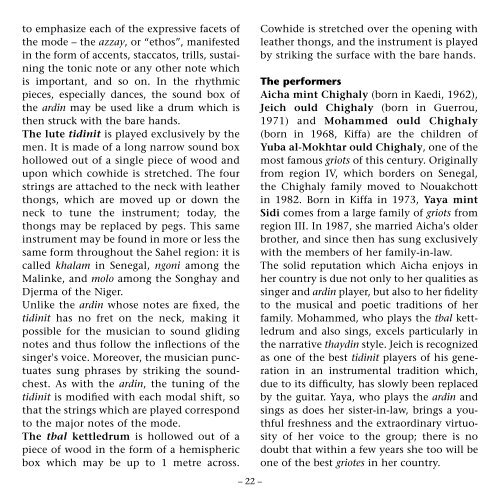AICHA MINT CHIGHALY, Mauritanie, l'art des griots ... - Free
AICHA MINT CHIGHALY, Mauritanie, l'art des griots ... - Free
AICHA MINT CHIGHALY, Mauritanie, l'art des griots ... - Free
You also want an ePaper? Increase the reach of your titles
YUMPU automatically turns print PDFs into web optimized ePapers that Google loves.
to emphasize each of the expressive facets of<br />
the mode – the azzay, or “ethos”, manifested<br />
in the form of accents, staccatos, trills, sustaining<br />
the tonic note or any other note which<br />
is important, and so on. In the rhythmic<br />
pieces, especially dances, the sound box of<br />
the ardin may be used like a drum which is<br />
then struck with the bare hands.<br />
The lute tidinit is played exclusively by the<br />
men. It is made of a long narrow sound box<br />
hollowed out of a single piece of wood and<br />
upon which cowhide is stretched. The four<br />
strings are attached to the neck with leather<br />
thongs, which are moved up or down the<br />
neck to tune the instrument; today, the<br />
thongs may be replaced by pegs. This same<br />
instrument may be found in more or less the<br />
same form throughout the Sahel region: it is<br />
called khalam in Senegal, ngoni among the<br />
Malinke, and molo among the Songhay and<br />
Djerma of the Niger.<br />
Unlike the ardin whose notes are fixed, the<br />
tidinit has no fret on the neck, making it<br />
possible for the musician to sound gliding<br />
notes and thus follow the inflections of the<br />
singer's voice. Moreover, the musician punctuates<br />
sung phrases by striking the soundchest.<br />
As with the ardin, the tuning of the<br />
tidinit is modified with each modal shift, so<br />
that the strings which are played correspond<br />
to the major notes of the mode.<br />
The tbal kettledrum is hollowed out of a<br />
piece of wood in the form of a hemispheric<br />
box which may be up to 1 metre across.<br />
–22–<br />
Cowhide is stretched over the opening with<br />
leather thongs, and the instrument is played<br />
by striking the surface with the bare hands.<br />
The performers<br />
Aicha mint Chighaly (born in Kaedi, 1962),<br />
Jeich ould Chighaly (born in Guerrou,<br />
1971) and Mohammed ould Chighaly<br />
(born in 1968, Kiffa) are the children of<br />
Yuba al-Mokhtar ould Chighaly, one of the<br />
most famous <strong>griots</strong> of this century. Originally<br />
from region IV, which borders on Senegal,<br />
the Chighaly family moved to Nouakchott<br />
in 1982. Born in Kiffa in 1973, Yaya mint<br />
Sidi comes from a large family of <strong>griots</strong> from<br />
region III. In 1987, she married Aicha's older<br />
brother, and since then has sung exclusively<br />
with the members of her family-in-law.<br />
The solid reputation which Aicha enjoys in<br />
her country is due not only to her qualities as<br />
singer and ardin player, but also to her fidelity<br />
to the musical and poetic traditions of her<br />
family. Mohammed, who plays the tbal kettledrum<br />
and also sings, excels particularly in<br />
the narrative thaydin style. Jeich is recognized<br />
as one of the best tidinit players of his generation<br />
in an instrumental tradition which,<br />
due to its difficulty, has slowly been replaced<br />
by the guitar. Yaya, who plays the ardin and<br />
sings as does her sister-in-law, brings a youthful<br />
freshness and the extraordinary virtuosity<br />
of her voice to the group; there is no<br />
doubt that within a few years she too will be<br />
one of the best griotes in her country.



